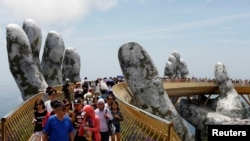Any tourists walking through a park in Ho Chi Minh City would be familiar with the scene: A young stranger approaches them, a Vietnamese asking if she can practice her English with them. In a homogeneous country where 85 percent of people are of the same ethnicity, most of them Buddhist, tourism is a key way to expose locals to people from a variety of backgrounds.
Record number of tourists arriving
Good news for the young English learners, then, that foreign holiday-goers to Vietnam are reaching record highs. The number of arrivals was 15 million in 2018, representing a doubling of the rate from six years earlier, according to research from HSBC, a retail and investment bank. Those arrivals bring with them a chance at cultural exchange, as well as the tourism revenue that Vietnam seeks as its economy changes.
The financial benefits are not just the income that a hotel makes when a guest hands over payment at the front desk. Consider Vietnam’s overall economy: Since it has benefited so much from the trade war between China and the United States, and from trade more generally, it is tempting for Vietnam to focus on the export of physical goods.
But the Southeast Asian country does not want to rely on physical exports, and that means moving toward more of a service based economy, including services like tourism.
Room for improvement in welcoming tourists
“Despite a rosy picture, Vietnam’s tourism sector still falls behind many countries in the region,” Yun Liu, an economist at HSBC, wrote in a briefing on tourism. “Simply looking at total tourist numbers in 2018, it still has enormous potential to grow compared to 38 million in Thailand.”She went on to add that Vietnam could “diversify the tourism products it offers.”
New Tourism Outlook
Some are heeding the call. Vietnam is no longer just a place to tour old war sites and eat pho on a sidewalk stool. Businesses have set up camps and bungalows for travelers in the hills of Da Lat. Enterprising students are offering motorbike food tours when they don’t have homework.
Homeowners have taken a liking to homestays, from simple rooms that they rent out to tourists, to full packages of accommodations in their apartments, breakfast, and city tours. The trend has been a boon to sharing site Airbnb, which has roughly 16,000 listings in Vietnam.
Events are increasingly attracting foreign visitors, like the marathons in Da Nang and Sa Pa, or the bicycle race in the old imperial capital of Hue. The Coupe de Hue gives us the perfect chance to promote the area and showcase its natural beauty,” said Les Walters, the director of activities at the neary Laguna Lang Co resort.
The flip side to increased tourism
Not everyone is on the same page. Pickpockets may like tourists, though they do not realize their quick buck can do lingering damage to Vietnam’s travel reputation. Then there is the damage done by tourists. Trash is piling up on the beaches of Phu Quoc, the waters of Ha Long Bay, and the terraced rice fields of Sa Pa.
A local Vietnamese man, who attended the Hue bicycle race, said he wished Vietnam could maintain a balance of the benefits of tourism without so much of the harm.
In his hometown, for example, he suggested preserving the imperial grounds to the north of the Perfume River, while allowing more development to the south of the river.
If Vietnam is going to have a balance, it will need to find it soon: The country is scheduled to start its first direct airline flights with the United States, its biggest trading partner, as early as next year. The number of tourists only shows signs of increasing.








